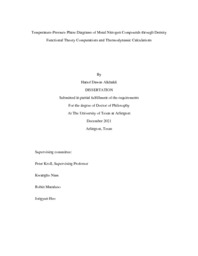
ATTENTION: The works hosted here are being migrated to a new repository that will consolidate resources, improve discoverability, and better show UTA's research impact on the global community. We will update authors as the migration progresses. Please see MavMatrix for more information.
Show simple item record
| dc.contributor.advisor | Kroll, Peter | |
| dc.creator | Alkhaldi, Hanof | |
| dc.date.accessioned | 2023-06-28T15:00:04Z | |
| dc.date.available | 2023-06-28T15:00:04Z | |
| dc.date.created | 2021-12 | |
| dc.date.issued | 2021-12-20 | |
| dc.date.submitted | December 2021 | |
| dc.identifier.uri | http://hdl.handle.net/10106/31371 | |
| dc.description.abstract | The need for novel materials for new generations of applications is growing tremendously. One of many pathways to attain new materials is the route of high pressure synthesis. A particular active area in this high–pressure research is to attain nitrogen-rich compounds. Many of these compounds discovered over the last decades have a potential use as hard material or as high–energy storage material. While it is not possible to predict a potential application for a compound before its experimental realization, it is worthy to explore beforehand what opportunities may exist. This kind of targeted development requires understanding of the synthesis process, potential structural polymorphism, and materials properties. Thus, it is necessary to support experimental endeavors with computational studies and explorations.
My research is divided into two parts. Part I outlines a pathway to compute pressure-temperature phase diagrams of N–rich compounds through a combination of available thermochemical data and quantum–chemical calculations. The approach is validated by comparing computed results to experimental data. This is done for phase boundaries appearing in three different systems: between molecular and polymeric nitrogen, between silicon nitride and silicon pernitride, and between nitrogen–rich Ti–N phases (Chapter I). In Part II the approach is applied to two systems with a rich structure diversity. We investigated the pressure-temperature phase diagram for tantalum–nitrogen (Chapter I) and for iron–nitrogen (Chapter II). The final chapter is then devoted to explore the ternary phase diagram Li–W–N at high pressure and high temperature. With the target of attaining tungsten in high oxidation state in a nitrogen compound, we first evaluate the binary W–N system, before we address ternary Li–W–N structures with their possible decomposition into binary W–N and Li–N phases. (Chapter III). | |
| dc.format.mimetype | application/pdf | |
| dc.subject | High-pressure compounds | |
| dc.subject | Phase diagram | |
| dc.subject | Chemical potential | |
| dc.subject | Nitrogen | |
| dc.title | TEMPERATURE-PRESSURE PHASE DIAGRAMS OF METAL NITROGEN COMPOUNDS THROUGH DENSITY FUNCTIONAL THEORY COMPUTATIONS AND THERMODYNAMIC CALCULATIONS | |
| dc.type | Thesis | |
| dc.date.updated | 2023-06-28T15:00:04Z | |
| thesis.degree.department | Chemistry and Biochemistry | |
| thesis.degree.grantor | The University of Texas at Arlington | |
| thesis.degree.level | Doctoral | |
| thesis.degree.name | Doctor of Philosophy in Chemistry | |
| dc.type.material | text | |
Files in this item
- Name:
- ALKHALDI-DISSERTATION-2021.pdf
- Size:
- 12.08Mb
- Format:
- PDF
This item appears in the following Collection(s)
Show simple item record


